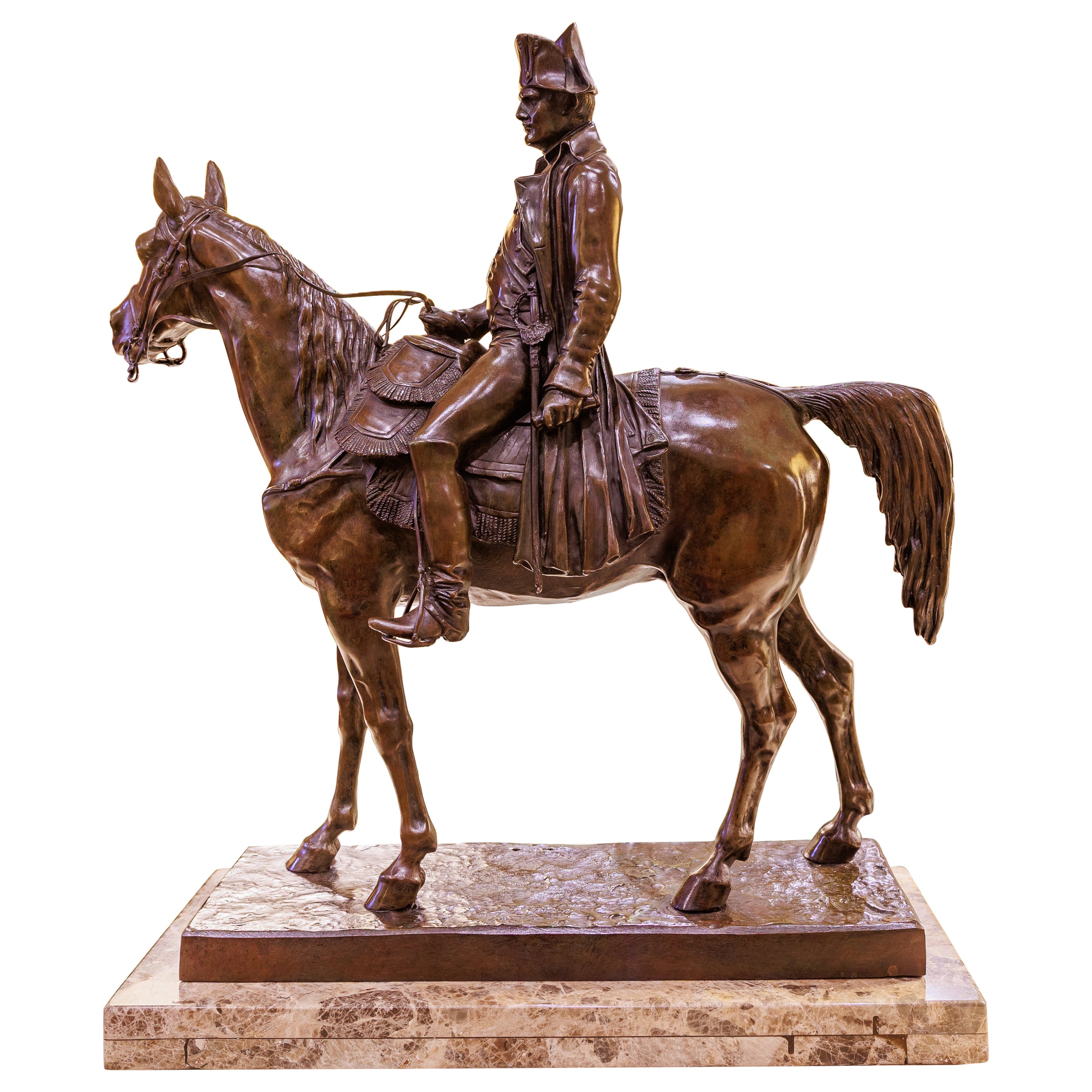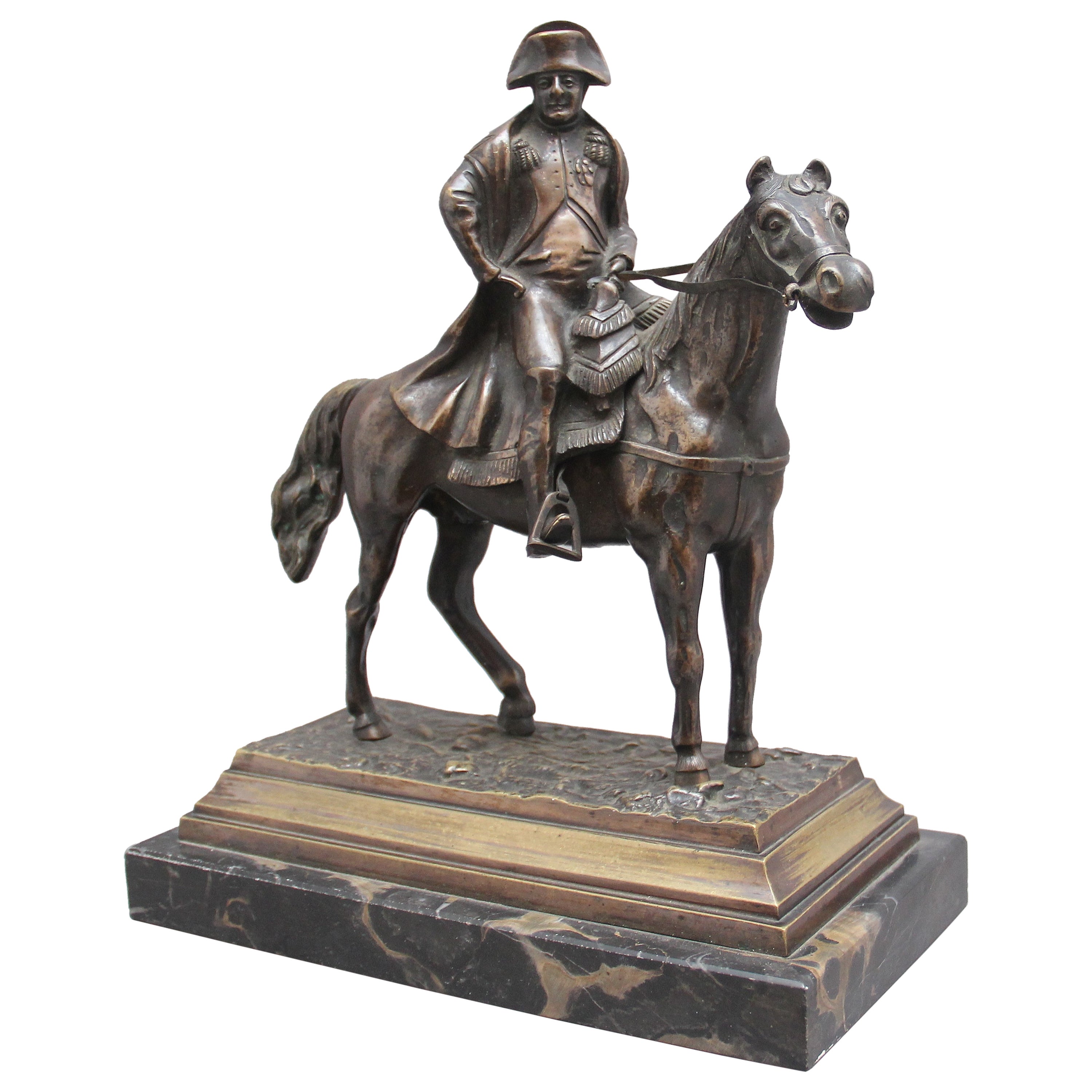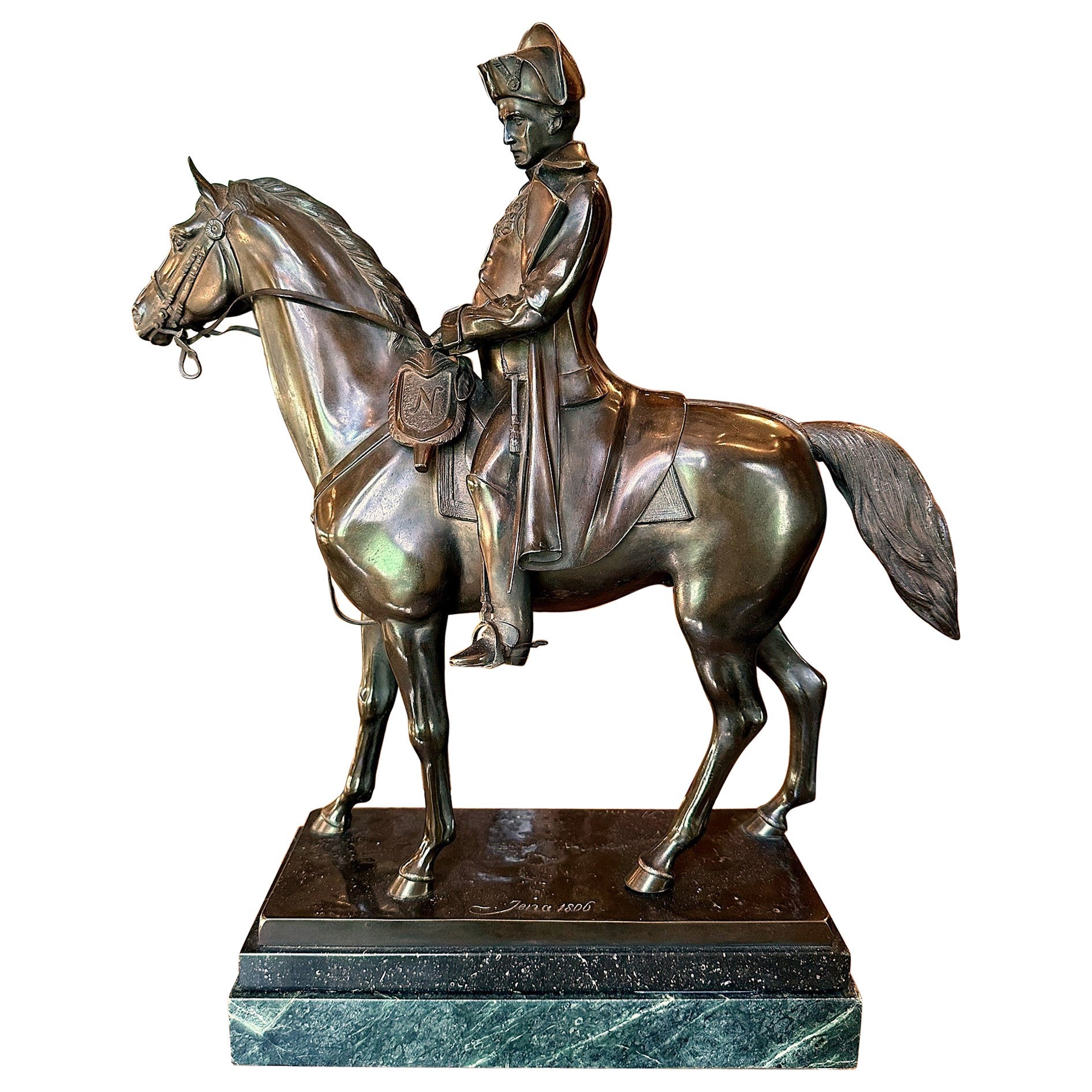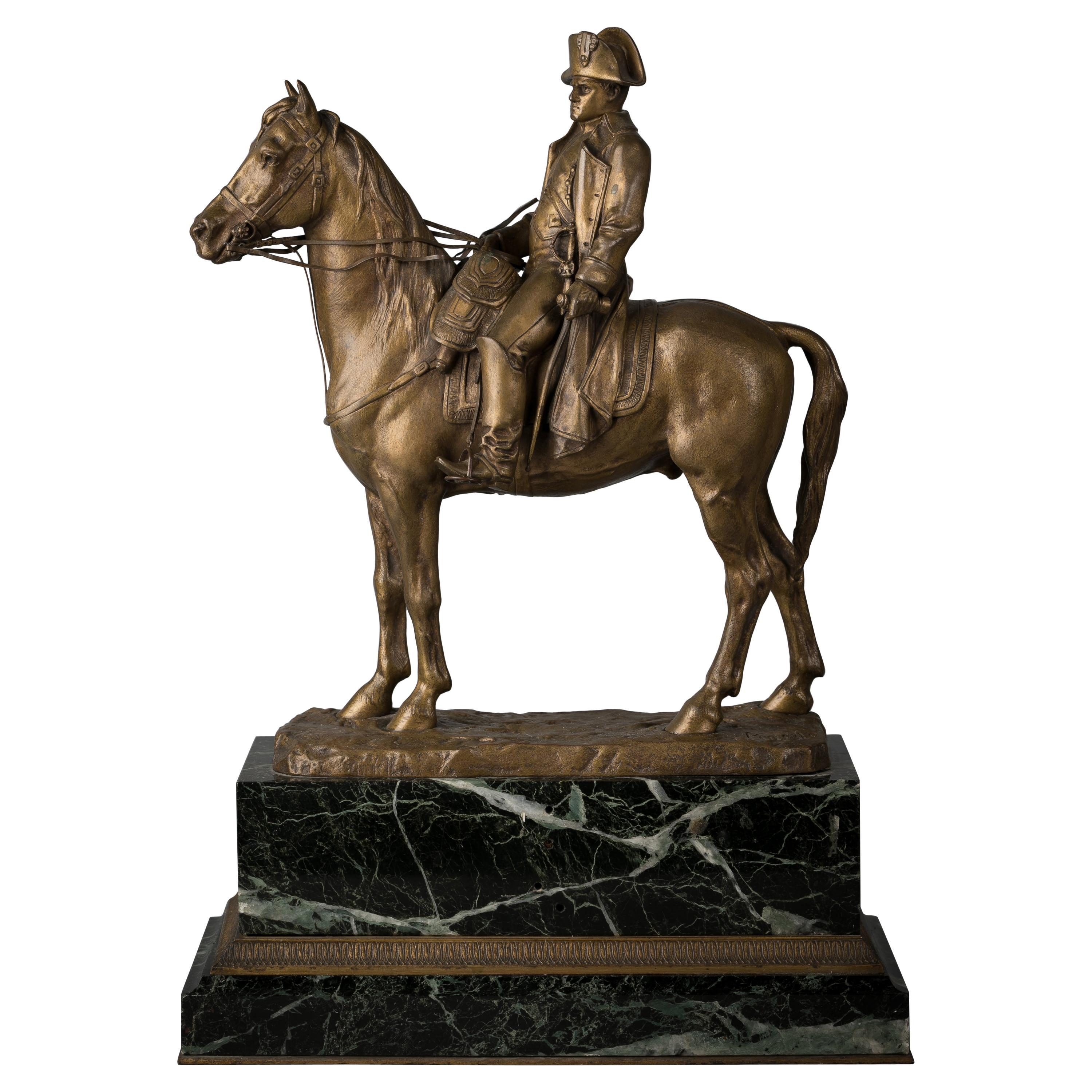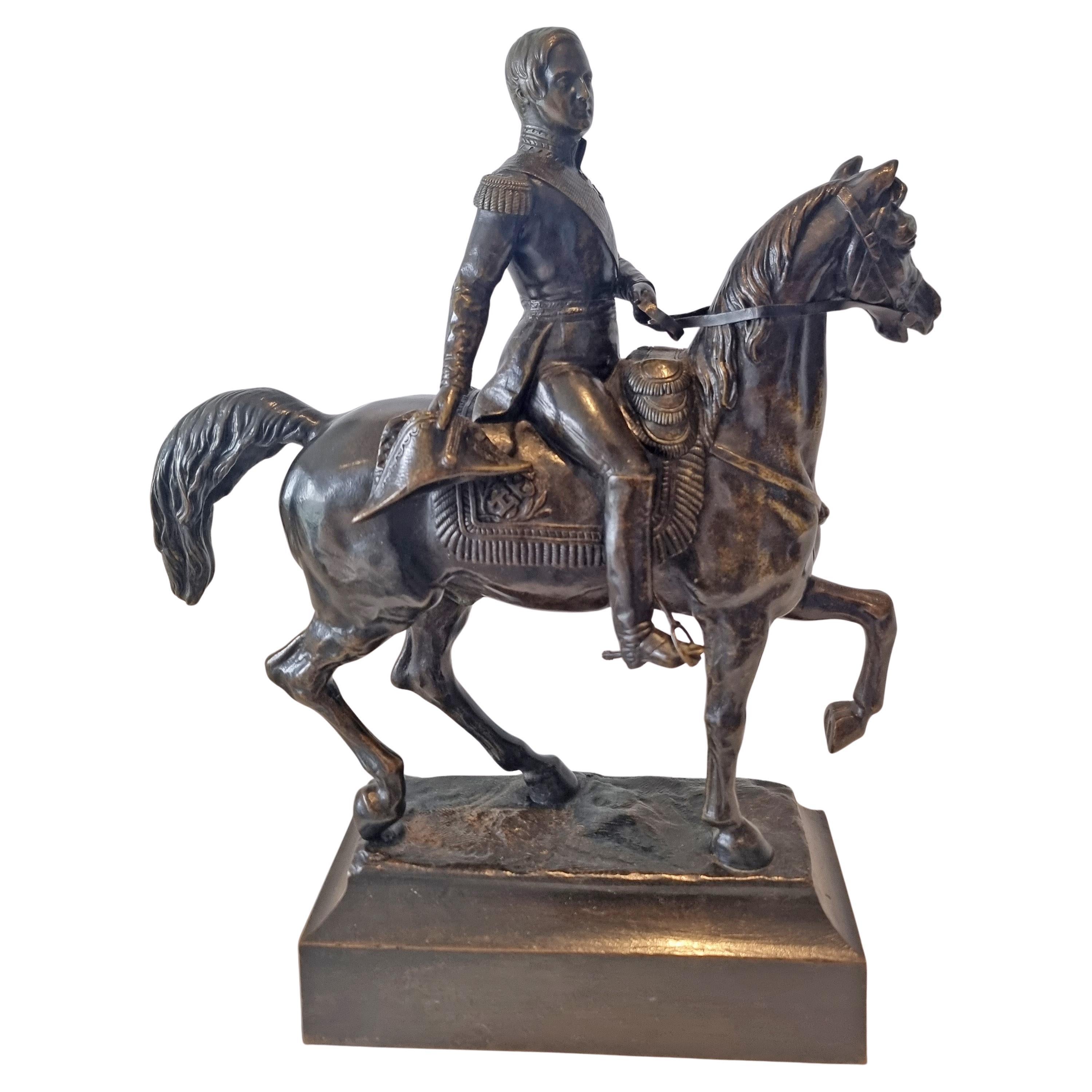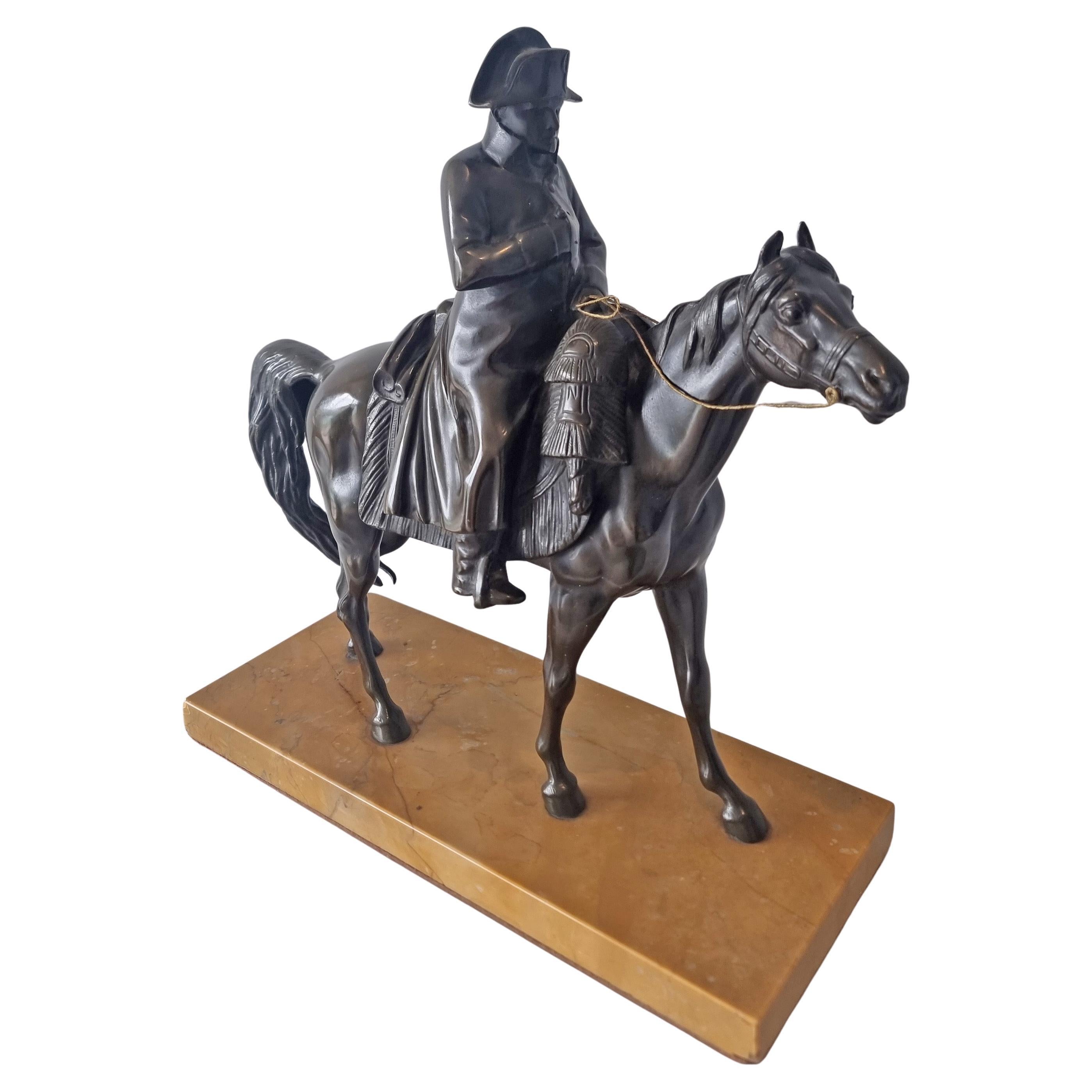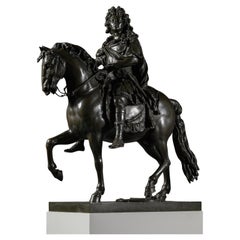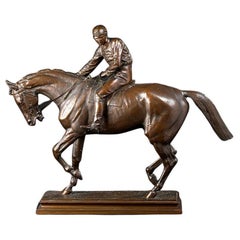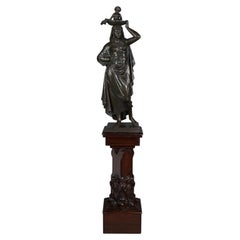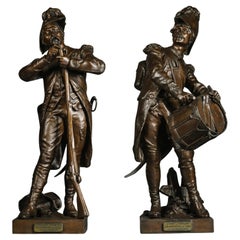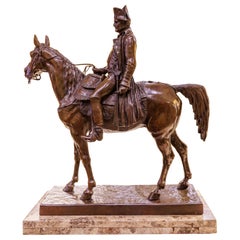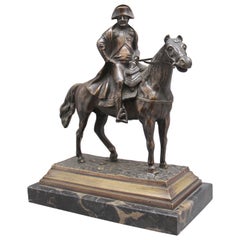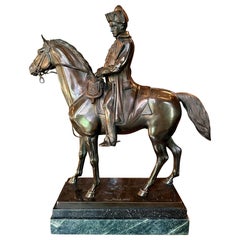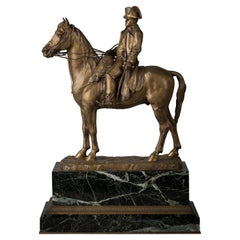Items Similar to Emperor Napoleon on Horseback, Cast by Susse Frères, Paris
Want more images or videos?
Request additional images or videos from the seller
1 of 12
Emperor Napoleon on Horseback, Cast by Susse Frères, Paris
$164,288.25
£120,000
€140,873.06
CA$230,494.93
A$253,247.87
CHF 130,598.31
MX$3,034,165.84
NOK 1,658,196.58
SEK 1,556,150.09
DKK 1,052,124.43
About the Item
A Large Patinated Bronze Sculpture of Emperor Napoleon on Horseback, Cast by Susse Frères, Paris, From the Model By Alfred Émilien O'Hara, Comte de Nieuwerkerke (1811-1892).
Dark brown patinated bronze.
Depicting the Emperor Napoleon on horseback in military attire with distinctive frock coat and famous bicorne hat, one hand holding the horses reigns the other symbolically resting on his heart, the saddle cloth richly emblazoned with the imperial cypher.
Signed to the cast, "Nieuwerkerke 1850", with "Susse Edit" for the Susse Frères foundry. Stamped ‘SUSSE FRES’ above a leaf mark alongside an indistinct pressed oval mark.
This large bronze equestrian group of the Emperor Napoleon astride his famous mount Morengo is a reduction of the monumental statue by the Comte de Nieuwerkerke (1811-1892) commissioned for the town of Lyon in 1850. One of the most iconic representations of Napoleon, it successfully captured the essence of the legendary leader, embodying his indomitable spirit and military prowess. The monumental version stood at nearly four and half meters high. Cast by MM. Eck and Durand it was inaugurated in the sculptor's presence by the Louis-Napoléon Bonaparte (Napoleon III) on 20 September 1852 on the largest square on the Perrache peninsula (now place Carnot) in Lyon.
Writing in the ‘Revue Des Beaux Art’s in 1852 the critic A. Galimard (1813-1880) devoted two pages in praise of the sculptural group noting:
‘On s'occupe beaucoup dans le monde des arts de la statue équestre de l'empereur Napoléon , commandée à M. le comte de Nieuwerkerke par la ville de Lyon. La noblesse du sujet et la célébrité de l'artiste auquel cette difficile tache a éçé confiée , devait, ajuste titre , exciter la curiosité et les sympathies publiques.’
Praising Nieuwerkerke’s meticulous rendering of the subject and its composition, Galimard noted how some modern sculptors in an equivocal way had been known to sacrifice the man for the depiction of the horse. However, Nieuwerkerke’s sculpture subordinated the horse to the Emperor in such a way as to preserve the artistic truth and beauty for both horse and rider.
‘Quelques statuaires modernes n'avaient su allier l'homme au cheval, qu'à la triste condition de sacrifier le cavalier à sa monture; et ce parti pris a malheureusement doté nos places publiques de productions d'un goût équivoque. Mais tout en subordonnant le cheval de l'Empereur à l'Empereur lui-même, ce statuaire a su conserver au coursier du grand capitaine la vérité et la beauté dans l'art.’
In summary Galimard grandly concludes that in sculptural form it compares to the famous eulogies of the great men of the ancient world by authors such as Plutarch and Tacitus.
‘Historien avec le ciseau comme d'autres le furent avec la plume , M, le comte de Nieuwerkerke a fixé dans le bronze l'épopée impériale avec l'éloquente simplicité dont PIutarque et Tacite nous ont laissé d'impérissables modelés dans l'éloge de leurs grands hommes.’
The grand original bronze of ‘L'Empereur Napoléon Ier à cheval’ in Lyon was destroyed between November 1870 and February 1871. The only surviving full size version is a repetition with minor variations, inaugurated on 20 August 1854 at the centre of ‘place Napoléon’ in La Roche-Sur-Yon.
Having received such universal praise and popularity Nieuwerkerke’s seminal sculpture of Napoleon on Horseback was cast in reduction by the Susse Frères foundry as recorded in their sales catalogues in 1860 and 1875 offered in five sizes, the present size titled ‘1re Grandeur’ being the largest. Nieuwerkerke choosing to instruct Susse Frères to cast his sculpture in bronze is a practice evidenced by his being recorded to have entered into edition contracts with Susse Frères in 1838, for his group of fighting horseman, and in 1843, for his equestrian statue of William of Orange. Bronze reductions, produced as part of the edition, would be made according to demand. Examples of Napoleon on Horseback in this, the largest size, are very rare. The only known comparative reduction by Susse Frères is in the collection of the château de Compiègne. Indeed, Emperor Napoleon III’s Royal Warrant was issued to Susse Frères in 1854 and the imperial family went on to spend considerable sums with the foundry. Patronage was no doubt accredited by Nieuwerkerke’s role as Intendent of the Beaux-Arts of the Household of His Majesty.
Beyond its artistic significance, the statue symbolises the resilience of France, honouring a leader whose legacy continues to shape the nation's identity.
France, Circa 1860.
- Creator:Susse Freres (Maker)
- Dimensions:Height: 38.59 in (98 cm)Width: 35.44 in (90 cm)Depth: 13 in (33 cm)
- Style:Napoleon III (Of the Period)
- Materials and Techniques:Bronze,Patinated
- Place of Origin:
- Period:
- Date of Manufacture:Circa 1860
- Condition:Wear consistent with age and use.
- Seller Location:Brighton, GB
- Reference Number:Seller: B769011stDibs: LU1028037428352
About the Seller
5.0
Recognized Seller
These prestigious sellers are industry leaders and represent the highest echelon for item quality and design.
Established in 1964
1stDibs seller since 2014
59 sales on 1stDibs
Typical response time: 1 hour
Associations
The British Antique Dealers' AssociationLAPADA - The Association of Arts & Antiques Dealers
- ShippingRetrieving quote...Shipping from: Brighton, United Kingdom
- Return Policy
Authenticity Guarantee
In the unlikely event there’s an issue with an item’s authenticity, contact us within 1 year for a full refund. DetailsMoney-Back Guarantee
If your item is not as described, is damaged in transit, or does not arrive, contact us within 7 days for a full refund. Details24-Hour Cancellation
You have a 24-hour grace period in which to reconsider your purchase, with no questions asked.Vetted Professional Sellers
Our world-class sellers must adhere to strict standards for service and quality, maintaining the integrity of our listings.Price-Match Guarantee
If you find that a seller listed the same item for a lower price elsewhere, we’ll match it.Trusted Global Delivery
Our best-in-class carrier network provides specialized shipping options worldwide, including custom delivery.More From This Seller
View All‘The Sun King' Louis XIV on Horseback, After François Girardon
By François Girardon
Located in Brighton, West Sussex
A Large Patinated Bronze Equestrian Group of ‘The Sun King' Louis XIV on Horseback, After François Girardon.
King Louis XIV dressed as a Roman Emperor, his right arm slightly raised...
Category
Antique 19th Century French Figurative Sculptures
Materials
Bronze
‘Le Grand Jockey' by Isidore Jules Bonheur
By Isidore Jules Bonheur
Located in Brighton, West Sussex
Isidore Jules Bonheur (French, 1827-1901)
‘Le Grand Jockey ‘
Signed 'I Bonheur' and with foundry stamp PEYROL EDITEUR'.
Bronze, rich mid-brown pa...
Category
Antique 19th Century French Animal Sculptures
Materials
Bronze
François Truphème (1820 -1880) - 'Moses and Jochebed'
By François Truphème, Thiebaut Freres
Located in Brighton, West Sussex
'Moses and Jochebed - A Fine Patinated Bronze Figural Group After A Model by 'François Truphème', Cast by 'Thiebaut Frères'.
Signed 'Fois Truphème 1863' and 'fdu par Vor Thiebaut'....
Category
Antique Mid-19th Century French Figurative Sculptures
Materials
Bronze
Pair of Bronze Figures by Etienne-Henri Dumaige
By Etienne-Henri Dumaige
Located in Brighton, West Sussex
A Fine Pair of Bronze Figures Entitled 'Avant le Combat' and 'Apres le Combat', Cast from the models by Etienne-Henri Dumaige (1830 - 1888).
Signed H. Dumaige, with title plaquet...
Category
Antique 19th Century French Figurative Sculptures
Materials
Bronze
Pair of Restoration Period Gilt-Bronze Figural Groups. French, circa 1830
Located in Brighton, West Sussex
An exceptional pair of restoration period gilt-bronze figural groups, allegorical of hunting and fishing.
Each group is set on a naturalistically modelled base and finely modelled...
Category
Antique Early 19th Century French Napoleon III Figurative Sculptures
Materials
Bronze
Large Multi-Patinated Bronze Figure of an Arab Warrior by Henri-Honoré Plé
By Henri Honoré Plé
Located in Brighton, West Sussex
A Large and Important Multi-Patinated Bronze Figure of an Arab Warrior by Henri Honoré Plé.
Signed Henri Plé to the base.
The figure is finely modelled as an Arab warrior, with sw...
Category
Antique 19th Century French Figurative Sculptures
Materials
Bronze
You May Also Like
Louis Marie Moris French bronze Napoleon on horseback . (1818-1883)
Located in Dallas, TX
A fine and large French bronze of Napoleon on horseback . Crossing the Alps on Marengo.
Fine detail on a marble base . Large and impressive scale
Category
Antique Mid-19th Century French Empire Animal Sculptures
Materials
Bronze
19th Century Bronze of Napoleon on Horseback
Located in Martlesham, GB
A lovely quality 19th century French bronze of Napoleon on horseback standing on a moulded bronze plinth terminating on a dark grey variegated ma...
Category
Antique 1880s French Figurative Sculptures
Materials
Bronze
$3,121 Sale Price
27% Off
Antique Austrian Bronze Sculpture of Napoleon on Horseback, after Alois Hernick.
Located in New Orleans, LA
Antique 19th Century Austrian Figural Bronze Sculpture on Green Marble Base of Napoleon on Horseback, after Alois Hernick (1870-1939).
Category
Antique Late 19th Century Austrian Figurative Sculptures
Materials
Marble, Bronze
French Gilt Bronze Figure of Napoleon, Emile Pinedo
Located in New York, NY
Signed Pinedo For Emile Pinedo (French 1840-1916). On marble base.
Category
Antique 1880s French Figurative Sculptures
Materials
Bronze
Patinated Bronze Sculpture of Napoleon on horseback
Located in London, GB
A fine patinated bronze sculpture of Napoleon on horseback. Superb detail and definition on this sculpture and pleasing rubbing to the patination.
Category
Antique 1860s French Figurative Sculptures
Materials
Bronze
Patinated Bronze Sculpture of Napoleon on his horse Marengo, on Sienna Marble
Located in London, GB
A fine patinated bronze sculpture of Napoleon Bonaparte on his horse Marengo. Set upon a sienna marble base.
Category
Antique 1860s French Figurative Sculptures
Materials
Siena Marble, Bronze
More Ways To Browse
William Of Orange
Antique Frock Coat
Susse Fres
Antique Hara
Napoleon On Horseback
Bronzes Of Equestrian Napoleon
Figural Torcheres
Florentine Sculpture
Francois Rude
Green Art Deco Sculpture
Lion Skin
Marble Sphinx
Marcel Andre Bouraine
Mid Century Nude Ceramic
Milos Greece
Porcelain Baby
Porcelain Buddha
Sabine Women
